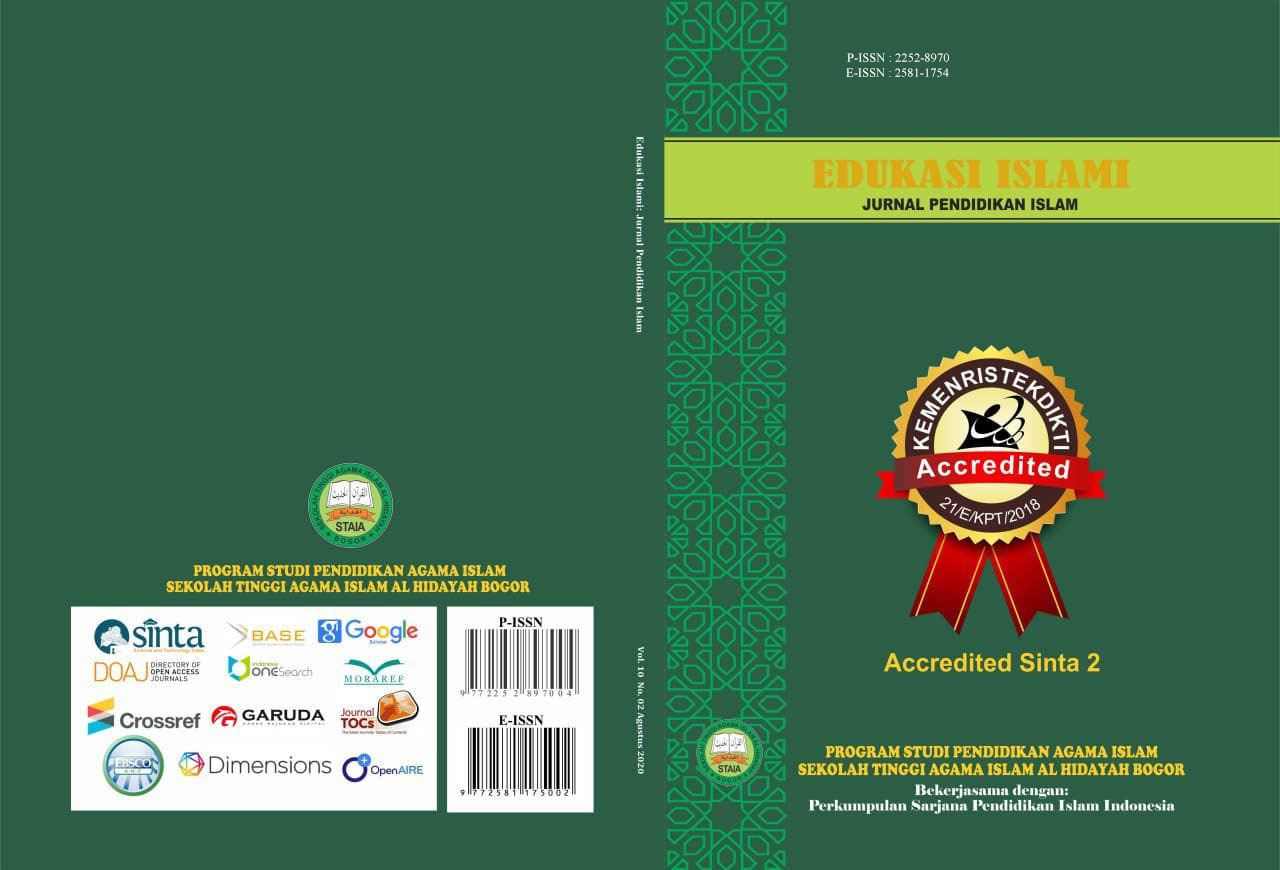AN ANALYSIS OF THE BARRIERS TO LEARNING QUR’ANIC READING AMONG RURAL MOTHERS
A Case Study of Wih Ilang Village, Takengon
DOI:
https://doi.org/10.30868/ei.v14i03.8767Keywords:
Qur’anic Reading, Rural Women, Barriers AnalysisAbstract
Background The ability of mothers to read the Qur’an still encounters various challenges in practice. This study aims to identify the causal factors experienced by mothers in learning Qur’anic recitation. Purpose: The mapping process was carried out through the recognition and categorization of the different forms of obstacles faced by rural mothers in their efforts to learn Qur’anic reading. Method: This research employs a qualitative method, specifically a case study with a grounded research approach. The study began with selecting cases from the population in rural Takengon. Three cases were chosen based on the consideration that this phenomenon reflects the reality currently taking place in the village. These three cases were then carefully observed. Result: The study found that the difficulties and obstacles faced by mothers in reading the Qur’an are caused by various factors involving important elements determining the success of Qur’anic reading. At least five main causes of difficulties and obstacles were identified, first cognitive limitations related to knowledge of Qur’anic sciences, second limited religious knowledge among most mothers, resulting in a weak foundation for correctly understanding Qur’anic recitation, third time constraints due to domestic duties and household responsibilities, which prevent consistent participation in learning, fourth a limited number of Qur’an teachers in the village, causing inadequate guidance for all participants, fifth the village’s difficult geographical conditions worsen accessibility to regular learning activities. Conclusion: Furthermore, the author categorizes the problems in learning Qur’anic reading into three aspects: cognitive and religious barriers, structural and resource barriers, and geographical and accessibility barriers. The findings indicate that these three types of obstacles are closely interrelated and require a holistic and sustainable approach to coaching and development.
References
Qanun Aceh, 8 Pemerintah Aceh 1 (2014).
Hasan, A. Metode Tahfiz Alquran, Metode Patas. Jakarta, Yayasan Alumni Perguruan Tinggi Ilmu Alquran, 2022.
Hasan, M. “Pengaruh Metode Takrir Dalam Meningkatkan Kemampuan Membaca Al-Quran Jama ’ ah Ibu-Ibu Majelis Ta’lim Miftahussa’aah Balikpapan.” Al-Manhaj: Jurnal Pendidikan Islam. 2(3) 2021. 4(1), 160–174.
Hidayah, P., Rahmadani, A., Syahputri, N., Wizaoktavia, R., & Lubis, R. “Problematika Pendidikan Agama Islam Di Desa Batu Layang.” MODELING: Jurnal Program Studi PGMI MODELING. 2023. 10(1), 204–213.
Hidayati, T. W., & Gufron, M. “The Qur’anic Education Strategies for the Indonesian Context: An investigation of the Halaqah of the Qur’an in Mecca and Medina.” Ijoaser: International Journal on Advanced Science, Education. 7(4) 2024. Di akses 15 juni 2025. https://ojs.staialfurqan.ac.id/IJoASER/article/view/733.
Husnaini, M., Amili, N., Kartika, B., & Al-hidabi, D. A. Y. (2022). Challenges Faced by IIUM Postgraduate Students in Conducting the Qur ’ an Memorization and Working for Living during their Study Period. 3(1), 21–32.
Inten, D. N., & Agustina, S. (2022). Qur ’ an Literacy Activities for Children and Parents during Children ’ s Study at Home. Al -Athfal Jurnal Pendidikan Anak, 8(1), 13–26.
Jailani, A. K., Deliani, N., & Batubara, J. “Strategi Pondok Tahfidz Ustadz Mahyuddin dalam Meningkatkan Motivasi Belajar Al- Qur’an Usia Dewasa dan Lansia.” Ikhlas: Jurnal Ilmiah Pendidikan Islam. 2025. http://doi.org/10.61132/ikhlas.v2i1.515
Martiningsih, D., Zamhari, A., & Agency, D. The Portrait of the Students’ Ability to Read and Write Al-Quran at UIN Ar-Raniry Aceh. 2022. https://doi.org/10.4108/eai.20-10-2021.2316309
Miles, M.B, Huberman, A.M, & S. J. Qualitative Data Analysis, A. Methods Sourcebook (3rd ed.). Sage. 2014.
Patton, M. Q. Qualitative research and evaluation methods (3rd ed.). Thousand Oaks: Sage. 2002.
Rahmah, Y. A., Afifah, N., Maknin, K., & Malang, U. M. (2021). Al-Qur ’ an Learning Model On The Qur ’ anic Fun Camp In Probolinggo. 1, 271–285. https://doi.org/10.19105/tjpi.v16i2.4860
Rukminingsih, Adnan, G., & Latief, M. A. “Metode Penelitian Pendidikan: Penelitian Kuantitatif, Penelitian Kualitatif, Penelitian Tindakan Kelas.” 2020. In Journal of Chemical Information and Modeling (Vol. 53, Issue 9).
Saeed, A. Reading the Qur ’ an in the Twenty- fi rst Century. Routledge. 2014.
Safi, A. “Learning To Read Al- Qur ’an For Adults : An Analysis Of The Implementation Of The Griya Al- Qur ’ an Method In Taklim Council.” 2023. Jurnal Pendidikan Glasser. 7 (2): 329. http://doi.org/10.32529/glasser.v7i2.2711.
Salam ;Zuhri; Sumaryati. “ANALYSIS OF QUR ’ AN MEMORIZATION LEARNING USING THE TALAQQÎ METHOD AT MI DARUL ISHLAH : EVALUATION AND.” 2025. Edukasi Islami: Jurnal Pendidikan Islam, 14(2), 333–340. https://doi.org/10.30868/ei.v14i02.8266
Sirin, M. Z., Sari, Y., Ramadhani, F., & Jamasir, D. (2021). “The Qur ’ an Learning in Islamic Education Institutions in Indonesia : An Analysis Study of the Problems and Solutions.” International Journal of Multtidisciplinary Research of Higher Education, 4, 146–155.
Syafruddin.” 65 Persen Muslim Indonesia tak Bisa Baca Alquran.” Republika Online. 2021.
Tokyan, M. Bin. “The problematics of Qur ’ an teaching in Singapore ’ s half-time Madrasah.” 2024. 5(2), 180–198. https://doi.org/10.32832/idarah.v5i2.16502
Downloads
Published
Issue
Section
Citation Check
License
Copyright (c) 2025 Muhammad Hatta, Muchamad Toif Chasani, Rijal Mahara

This work is licensed under a Creative Commons Attribution 4.0 International License.
Authors who publish with this journal agree to the following terms:
- Authors retain copyright and grant the journal right of first publication with the work simultaneously licensed under a Creative Commons Attribution License that allows others to share the work with an acknowledgment of the work's authorship and initial publication in this journal.
- Authors are able to enter into separate, additional contractual arrangements for the non-exclusive distribution of the journal's published version of the work (e.g., post it to an institutional repository or publish it in a book), with an acknowledgment of its initial publication in this journal.
- Authors are permitted and encouraged to post their work online (e.g., in institutional repositories or on their website) prior to and during the submission process, as it can lead to productive exchanges, as well as earlier and greater citation of published work (See The Effect of Open Access).









